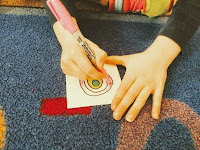Some shared knowledge about what we know about circles;
- round
- flat (2D)
- is a curve line
- smooth
- looks like the vowel o
I shared a picture of the artist Wassily Kandinksy and one of his famous math paintings; squares with concentric circles. We talked about how the circles he painted had a common - or the same - center. The children have been working with color words, adding them to our word library. We talked about the colors in Kandinsky's work, noticing how some of the colors blended together. We revisited earlier conversations about the difference between a square and a circle. We read the book Round and thought about the beautiful circles in our environment - circles we see every day.
Each Kindergartener had a canvas tile (square) to work on. On their square they drew their own concentric circles using sharpies and crayons. We then added water color over each tile. When placed together, their circles will create a collaborative piece inspired by Kandinsky as well as our work with colors, shapes, and community. It is moments like these, that I am reminded of the importance of art integration - especially in primary classrooms.
When children came into the classroom in the morning and saw the little square canvases, sharpies, and paint their eyes lit up. They jumped up and down and asked, are we going to create art today? Sometimes questions like that sadden me, because children create art every day, and we should be encouraging them to recognize that. We should also be providing classroom environments and learning experiences that inspire, challenge, and excite children. We shouldn't get stuck in the mundane, we must integrate the arts in meaningful and authentic ways. A child shouldn't be surprised by a blank canvas, because they should see every day as a blank canvas.
Look for our final piece hanging in the common area.









No comments:
Post a Comment